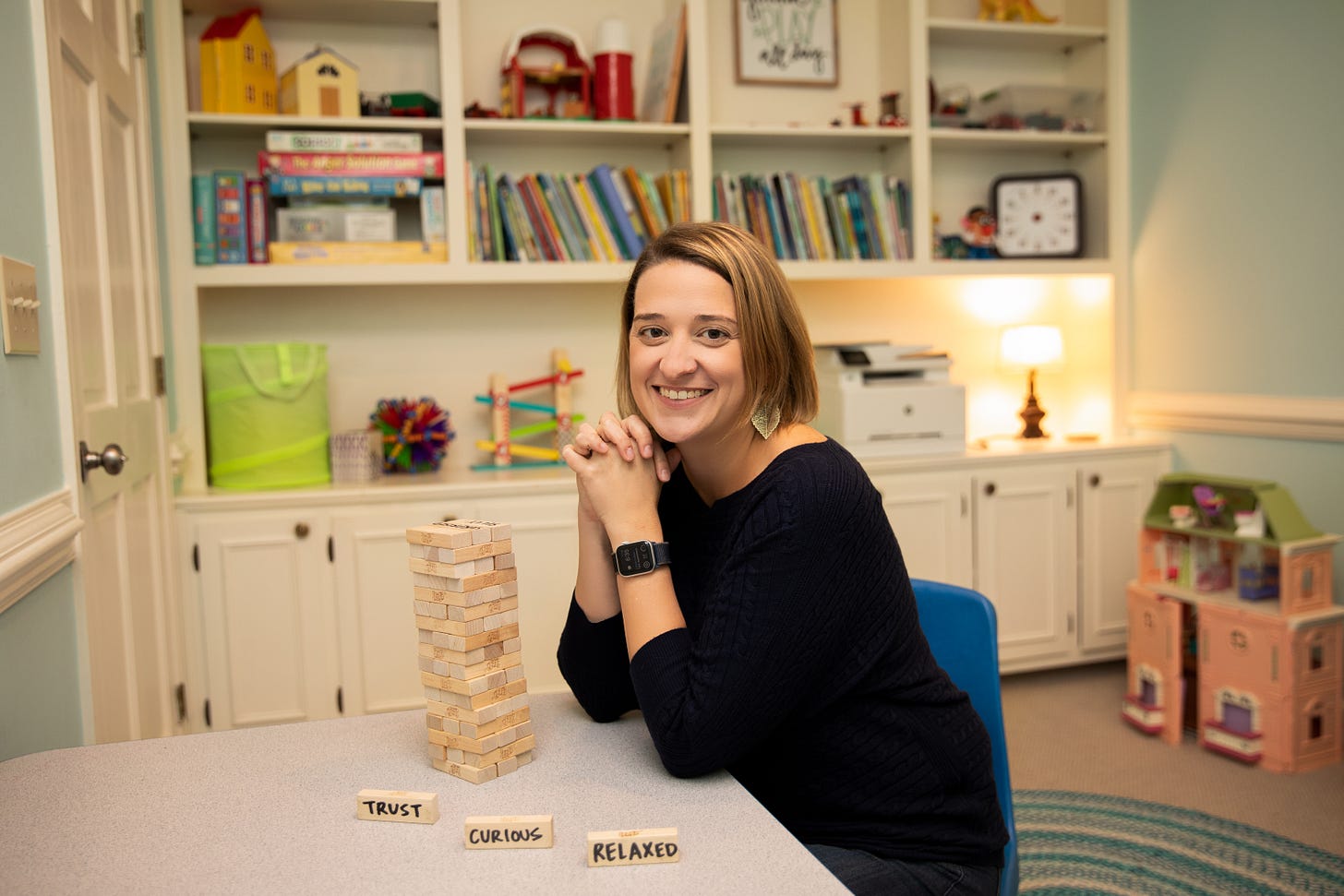
In my work with parents of young children, many come to me after noticing differences in their child’s development. While all children develop at their own pace, some children experience challenges with emotional regulation, communication, motor, and/or sensory processing skills that leave their parents overwhelmed and wondering if an evaluation is needed.
You likely already know that children need an evaluation to receive support services at school or a clinical diagnosis for insurance to cover therapy. But some parents who privately pay for therapy services or enroll their child in private school wonder: Is a diagnostic evaluation really necessary?
The short answer is "Yes." An evaluation is the beginning of your journey in learning how to connect with and support your child, and how to help others do the same. It tells you where to go next, and without it, you run the risk of your child being misunderstood. Children grow and change over time so having an evaluation in the preschool years to serve as a “snapshot” of how they were developing at that time can be incredibly helpful to look back on when your child is older.
So, how to you decide when it’s time for an evaluation? I always ask parents these questions:
Is your child’s behavior interfering with their ability to settle into sleep, connect with you, calm themselves when upset, or engage in play?
Is their emotional overwhelm causing stress at times of transition, toileting, bedtime, or eating?
Is your child’s emotional overwhelm (behavior) getting in the way of your child getting to school or daycare in the morning, transitioning throughout their day, or learning new skills?
If yes, then it is time to investigate. What are the lagging skills? What are the strengths? What are the triggers? Answering these questions will lead you to plan for the best school fit, the best support at home, and the best interventions. This path leads to your child feeling seen and understood. More on all of this in the workshop below.
[FREE REPLAY] All About Evaluations for Autism, ADHD, & Twice-exceptionality
In this workshop you will learn:
Clinical Diagnoses vs. Educational Classification
So, what is the difference between clinical and educational? Psychiatrists, psychologists, and other therapists in the United States use the Diagnostic and Statistical Manual of Mental Disorders, Fifth Edition (DSM-5-TR) to classify a diagnosis, which is needed for insurance purposes. According to the DSM-5-TR, there are three types of ADHD, one Autism Spectrum Disorder with three levels of severity, multiple types of learning disabilities, and different types of anxiety and depressive disorders.
On the other hand, there are only 13 educational classifications under the Individuals with Disabilities Education Act (IDEA), the federal law protecting the rights of children with disabilities to a public education. Therefore, a child’s educational classification is not as specific as their clinical diagnosis. This is fine, as long as everyone working with your child has access to comprehensive evaluation reports and fully understands your child's strengths and needs for support beyond their educational classification. Parent-teacher collaboration begins here and is the most important relationship you can foster during your child’s school-age years.
A Note About Special Education in the United States
Under public education law 94-142, children with disabilities are to be educated in the Least Restrictive Environment (LRE) with their same-age peers to the maximum extent possible. While LRE promotes inclusion, there are some circumstances where learning in a larger group is overwhelming for a child. Smaller special education classrooms are more appropriate in these instances; however, students with disabilities are included with their neurotypical peers in the general education classroom as much as possible. This is why I’m so passionate about helping all teachers, not just special educators, stay up to date of the evolving field of understanding neurodivergent learners.
Special education services, of course, are only available in public schools. Some families choose to homeschool or enroll their child in private school. However, private schools are not required by law to admit your child or provide supports for your child. Your child can also be asked to leave if a private school feels they cannot support your child’s needs.
Facing Your Fear of the Label
I have walked this path as a parent so I understand how emotional the experience of the evaluation process can be. It feels like you’re about to open a door you can never close again. Just trust me, once you better understand your child’s brain, you will never want to close that door; you will want to walk through it with your child and help the rest of the world understand them better.
Every parent experiences this phase differently. Some are so fearful of having their child labeled that they put off their child’s evaluation, delaying much-needed services. Some parents will begin therapies to support their child’s symptoms, but the larger question of what is explaining their child’s developmental needs remains. Others have their child evaluated but wait until their child notices they feel different to explain to them how their brain works.
You will figure out what is best for your child, just know that most parents I work with are so thankful for the detailed evaluation and recommendations of what to do next. Years later, parents are so glad they started the process when they did. Your child deserves to understand how they learn and you can’t help them understand it until you understand it first.
Your Child’s Inner Experience vs. Observable Behavior
In my own training for conducting evaluations, all data collected was based on a clinician’s observations and caregiver’s description of a child’s behavior. But we are beginning to learn more and more about the lived experience of neurodivergence by listening to first-person accounts.
Some children don’t have the communication skills or insight yet to express what they experience, but if they do, we need to listen. For instance, our child’s description of sensory overwhelm or anxiety related to academic demands is not only valid but highly informative to those working with them, especially if their experience doesn’t match their outward behavior due to masking.
What a Diagnosis Is and Is Not
While a diagnosis does not change your child, it should change the perspective of everyone who is working with them. If a child was considered “difficult” or “noncompliant” before the diagnosis, now they are seen as “having difficulty” due to a skill weakness, or “overwhelmed” due to anxiety or sensory sensitivities.
A teacher may have misunderstood a sensory meltdown for “acting-out” behavior, but after a diagnosis we have more information to get curious about what triggered a stress response. A child who was described as "aloof" or "self-directed" before an evaluation, now has parents and teachers who understand that solo play helps them regulate their emotions. Now, they leave solo play uninterrupted and learn how to support emotional regulation and engagement before dysregulation happens.
Remember: No two children are the same. Not even two children with the same clinical diagnosis or educational classification. A comprehensive evaluation will outline your child’s individual differences, but a diagnosis will not.
The diagnosis is never the finish line. It is not where we stop asking questions because we think we understand the child based on one word or phrase. The diagnosis is the starting line, where we begin to understand and ask more questions about how to support, teach, and connect with a child.
Changing Your Mindset
Parents will say, “I don’t want him labeled because I don’t want his teacher to expect less of him.” The truth, however, is that many problematic behaviors are a child's stress response to teachers and parents expecting too much. An evaluation can outline your child’s individual strengths and weaknesses so that you know where to add support for weaker skills while continuing to encourage strengths and areas of interest.
Imagine the child who is very intelligent but who cannot emotionally regulate in order to learn in a classroom. No one can learn without first feeling emotionally safe, which requires us to connect, trust, or engage with those who are teaching us.
Think about how you feel when you are really stressed; not much thinking or learning happens until you feel calm again, right? Or, how would you feel sitting in a classroom where the instructor is only speaking a language you don’t speak. You’d be pretty disengaged, right? We wouldn't expect much from you until you could understand what is being asked of you. If you were required to participate without the necessary skills, you would likely feel anxious, avoid engaging, or quit altogether. So, sometimes, lower demands are exactly what a child needs to feel satisfied with their progress.
It’s Better Over Here
Prior to a diagnosis, there is often confusion about what a child can do versus what they are choosing to do. After the diagnosis, you enter a world where behaviors are seen as stress responses to be solved rather than your child’s “choice.” As your child gains skills, you are better able to see where to set expectations to guide them because you know more about their capacity.
When you accept your child’s diagnosis, you walk through a figurative door, and on the other side is more understanding of your child's strengths, interests, and knowledge of what they need to thrive. It’s better over here.
Let’s Stay Connected!
~Dr. Emily
I’m Dr. Emily, child psychologist and former school psychologist, and I’m on a mission to help parents and teachers be the best adults we can be for the neurodivergent kids and teens in our lives. This isn’t about changing the kids, it’s about changing us. Learn more with my resources for parents, teachers, and schools at www.learnwithdremily.com.
**All content provided is protected under applicable copyright, patent, trademark, and other proprietary rights. All content is provided for informational and education purposes only. No content is intended to be a substitute for professional medical or psychological diagnosis, advice or treatment. Information provided does not create an agreement for service between Dr. Emily W. King and the recipient. Consult your physician regarding the applicability of any opinions or recommendations with respect to you or your child's symptoms or medical condition. Children or adults who show signs of dangerous behavior toward themselves and/or others, should be placed immediately under the care of a qualified professional.**





![[FREE REPLAY] All About Evaluations for Autism, ADHD, & Twice-exceptionality](https://substackcdn.com/image/fetch/$s_!5ZfZ!,w_1300,h_650,c_fill,f_auto,q_auto:good,fl_progressive:steep,g_auto/https%3A%2F%2Fsubstack-video.s3.amazonaws.com%2Fvideo_upload%2Fpost%2F163215565%2F62a38f46-5125-4ea6-b22f-fdf75dea3b3a%2Ftranscoded-1746805108.png)
